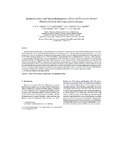Antinociceptive and anti-inflammatory effects of Dorstenia barteri (Moraceae) leaf and twig extracts in mice

Date
2004Author
Omisore, N.
Adewunmi, C.
Iwalewa, E.
Ngadjui, B.
Watchueng, J.
Abegaz, B.
Ojewole, J.
Publisher
Elsevier Ltd. www.elsevier.com/locate/jethpharmType
ArticleMetadata
Show full item recordAbstract
The present studywas undertaken to investigate the antinociceptive and anti-inflammatory activities of the leaf and twig extracts of Dorstenia
barteri (Moraceae) in mice. Both the leaf and twig extracts of Dorstenia barteri at 50, 100 and 200 mg/kg showed significant (P < 0.05-0.01)
antinociceptive activities in chemical-, mechanical- and thermal-induced pain test models. Intraperitoneal administration of the plant extracts
at 50, 100 and 200 mg/kg significantly (P < 0.05-0.01) inhibited carrageenin-induced acute inflammation in oedema paw weight, pulmonary
oedema and number of pleural leucocytes in a dose-dependent way. The twig extract was found to be more active than the leaf extract in all the
experimental models used. The inhibitory effects of the plant extracts were comparable to those of the reference drugs acetylsalicyclic acid
(ASA) and phenylbutazone (PBZ) at 100 mg/kg i.p. The significant reduction in acetic acid-induced abdominal contractions, the decrease in
oedema paw weight as well as in the number of leucocytes in the pleural cavity exudates, and the significant increase in the reaction time
and pain threshold of mice observed in this study suggest that Dorstenia barteri extracts possess both anti-inflammatory and antinociceptive
activities. The present study, therefore, lend pharmacological support to the folkloric uses of Dorstenia barteri extracts in the treatment,
control and/or management of arthritis, rheumatism, gout, headache and other forms of body pains in some parts of Africa.
